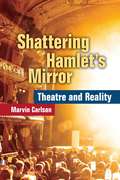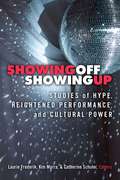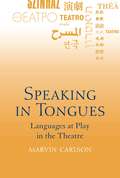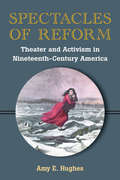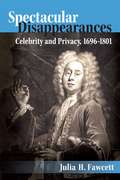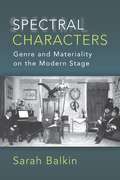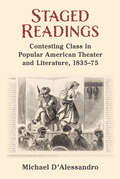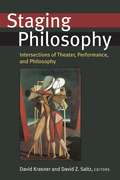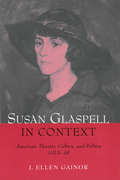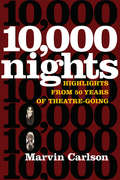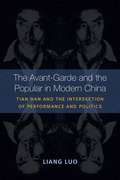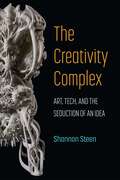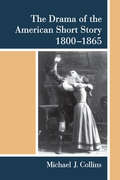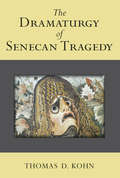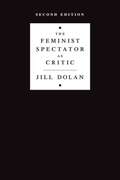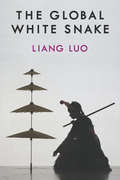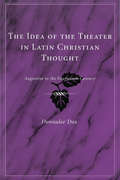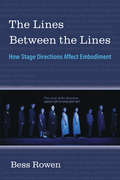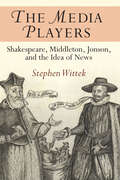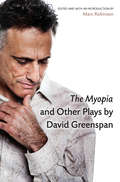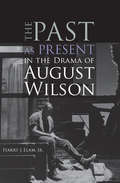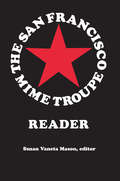- Table View
- List View
Shakespeare behind Bars: One Teacher's Story of the Power of Drama in a Women's Prison
by Jean TrounstineIn this deeply stirring account, Jean Trounstine, who spent 10 years teaching at Framingham (MA) Women's Prison, focuses on six inmates who, each in her own way, discover in the power of Shakespeare a way to transcend the painful constraints of incarceration. Shakespeare Behind Bars is a powerful story about the redemptive power of art and education. Originally published in cloth in 2001, the paperback includes a new foreword that will inspire all teachers who work with students others have deemed unteachable. A new afterword updates readers on the prison art's program -- and the author herself -- since 2001.
Shattering Hamlet's Mirror: Theatre and Reality
by Marvin CarlsonTheatrical playing, Hamlet famously averred, holds a mirror up to nature. But unlike the reflections in the mirror, the theater's images are composed of real objects, most notably bodies, that have an independent existence outside the world of reflection. Throughout Western theater history there have been occasions when the reality behind the illusion was placed on display. In recent years theaters in Europe and North America have begun calling attention to the real in their work--presenting performers who did not create characters and who may not even have been actors, but who appeared on stage as themselves; texts created not by dramatic authors but drawn from real life; and real environments sometimes shared by actors and performers and containing real elements accessible to both. These practices, argues Marvin Carlson, constitute a major shift in the practical and phenomenological world of theater, and a turning away from mimesis, which has been at the heart of the theater since Aristotle. Shattering Hamlet's Mirror: Theatre and Reality examines recent and contemporary work by such groups as Rimini Protokoll, Societas Raffaelo Sanzio, the Gob Squad, Nature Theatre of Oklahoma, and Foundry Theatre, while revealing the deep antecedents of today's theater, placing it in useful historical perspective. While many may consider it a post-postmodern phenomenon, the "theater of the real," as it turns out, has very deep roots.
Showing Off, Showing Up: Studies of Hype, Heightened Performance, and Cultural Power
by Catherine A. Schuler Kimberley Bell Marra Laurie FrederikThe interdisciplinary essays in Showing Off, Showing Up examine acts of showing, a particular species of performance that relies on competition and judgment, active spectatorship, embodied excess, and exposure of core values and hidden truths. Acts of showing highlight those dimensions of performance that can most manipulate spectators and consumers, often through over-the-top heightening and skewing of presentation. Many forms of showing and of heightened performance, however, operate more enigmatically and covertly while still profoundly affecting the social world, even if our reactions to them are initially flippant or unconcerned because “it’s just a show.” Examining a wide range of examples—from dog shows to competitive dancing to carnivals to striptease, the essays illuminate how such events variously foster competition, exaggerate a characteristic, and reveal hidden truths. There is as much to be learned about the power of showing through subtlety and underlying intentionality as through overt display. The book’s theoretical introduction and 12 essays by leading scholars reveal how diverse, particularly efficacious genres of showing are theoretically connected and why they merit more concerted attention, especially in the 21st century.
Speaking in Tongues: Languages at Play in the Theatre
by Marvin CarlsonCarlson (theater and comparative literature, City U. of New York--Graduate Center) suggests how linguistic theory and theater practice at the close of the 20th century challenge conventional thinking about theatrical language and the various ways that language can function in the theater. The macaronic stage, post-colonial heteroglossia, and post-modern language play are among his perspectives. Annotation ©2006 Book News, Inc., Portland, OR (booknews.com)
Spectacles of Reform: Theater and Activism in Nineteenth-Century America
by Hughes Amy E.In the nineteenth century, long before film and television arrived to electrify audiences with explosions, car chases, and narrow escapes, it was America's theaters that offered audiences such thrills, with "sensation scenes" of speeding trains, burning buildings, and endangered bodies, often in melodramas extolling the virtues of temperance, abolition, and women's suffrage. In Spectacles of Reform , Amy E. Hughes scrutinizes these peculiar intersections of spectacle and reform, revealing that spectacle plays a crucial role in American activism. By examining how theater producers and political groups harnessed its power and appeal, Hughes suggests that spectacle was—and remains—central to the dramaturgy of reform. Engaging evidence from lithographs to children's books to typography catalogs, Hughes traces the cultural history of three famous sensation scenes—the drunkard suffering from the delirium tremens, the fugitive slave escaping over a river, and the victim tied to the railroad tracks—assessing how they conveyed, allayed, and denied concerns about the rights and responsibilities of citizenship. These images also appeared in printed propaganda, suggesting that the coup de théâtre was an essential part of American reform culture. Additionally, Hughes argues that today's producers and advertisers continue to exploit the affective dynamism of spectacle, reaching an even broader audience through film, television, and the Internet. To be attuned to the dynamics of spectacle, Hughes argues, is to understand how we see. Consequently, Spectacles of Reform will interest not only theater historians, but also scholars and students of political, literary, and visual culture who are curious about how U. S. citizens saw themselves and their world during a pivotal period in American history.
Spectacular Disappearances: Celebrity and Privacy, 1696-1801
by Julia H. FawcettHow can people in the spotlight control their self-representations when the whole world seems to be watching? The question is familiar, but not new. Julia Fawcett examines the stages, pages, and streets of eighteenth-century London as England's first modern celebrities performed their own strange and spectacular self-representations. They include the enormous wig that actor Colley Cibber donned in his comic role as Lord Foppington-and that later reappeared on the head of Cibber's cross-dressing daughter, Charlotte Charke. They include the black page of Tristram Shandy, a memorial to the parson Yorick (and author Laurence Sterne), a page so full of ink that it cannot be read. And they include the puffs and prologues that David Garrick used to heighten his publicity while protecting his privacy; the epistolary autobiography, modeled on the sentimental novel, of Garricks protégée George Anne Bellamy; and the elliptical poems and portraits of the poet, actress, and royal courtesan Mary Robinson, a. k. a. Perdita. Linking all of these representations is a quality that Fawcett terms "over-expression," the unique quality that allows celebrities to meet their spectators' demands for disclosure without giving themselves away. Like a spotlight so brilliant it is blinding, these exaggerated but illegible self-representations suggest a new way of understanding some of the key aspects of celebrity culture, both in the eighteenth century and today. They also challenge divides between theatrical character and novelistic character in eighteenth-century studies, or between performance studies and literary studies today. The book provides an indispensable, history for scholars and students in celebrity studies, performance studies, and autobiography-and for anyone curious about the origins of the eighteenth-century self. Book jacket.
Spectral Characters: Genre and Materiality on the Modern Stage
by Sarah BalkinTheater’s materiality and reliance on human actors has traditionally put it at odds with modernist principles of aesthetic autonomy and depersonalization. Spectral Characters argues that modern dramatists in fact emphasized the extent to which humans are fictional, made and changed by costumes, settings, props, and spoken dialogue. Examining work by Ibsen, Wilde, Strindberg, Genet, Kopit, and Beckett, the book takes up the apparent deadness of characters whose selves are made of other people, whose thoughts become exteriorized communication technologies, and whose bodies merge with walls and furniture. The ghostly, vampiric, and telepathic qualities of these characters, Sarah Balkin argues, mark a new relationship between the material and the imaginary in modern theater. By considering characters whose bodies respond to language, whose attempts to realize their individuality collapse into inanimacy, and who sometimes don’t appear at all, the book posits a new genealogy of modernist drama that emphasizes its continuities with nineteenth-century melodrama and realism.
Staged Readings: Contesting Class in Popular American Theater and Literature, 1835-75
by Michael D'AlessandroStaged Readings studies the social consequences of 19th-century America’s two most prevalent leisure forms: theater and popular literature. In the midst of watershed historical developments—including numerous waves of immigration, two financial Panics, increasing wealth disparities, and the Civil War—American theater and literature were developing at unprecedented rates. Playhouses became crowded with new spectators, best-selling novels flew off the shelves, and, all the while, distinct social classes began to emerge. While the middle and upper classes were espousing conservative literary tastes and attending family matinees and operas, laborers were reading dime novels and watching downtown spectacle melodramas like Nymphs of the Red Sea and The Pirate’s Signal or, The Bridge of Death!!! As audiences traveled from the reading parlor to the playhouse (and back again), they accumulated a vital sense of social place in the new nation. In other words, culture made class in 19th-century America. Based in the historical archive, Staged Readings presents a panoramic display of mid-century leisure and entertainment. It examines best-selling novels, such as Harriet Beecher Stowe’s Uncle Tom’s Cabin and George Lippard’s The Quaker City. But it also analyzes a series of sensational melodramas, parlor theatricals, doomsday speeches, tableaux vivant displays, curiosity museum exhibits, and fake volcano explosions. These oft-overlooked spectacles capitalized on consumers’ previous cultural encounters and directed their social identifications. The book will be particularly appealing to those interested in histories of popular theater, literature and reading, social class, and mass culture.
Staging Philosophy: Intersections of Theater, Performance, and Philosophy
by David Krasner David Z. SaltzScholars of drama, philosophy, and literature apply insights from current philosophical theories to performance theory. Writing for non-specialists in the philosophy of performance, they consider such topics as critical realism and performance strategies, the ontology of presence reconsidered, and the Black arts movement and logo-centrism. Annotation ©2007 Book News, Inc. , Portland, OR (booknews. com)
Susan Glaspell in Context
by J. Ellen GainorSusan Glaspell in Context not only discusses the dramatic work of this key American author -- perhaps best known for her short story "A Jury of Her Peers" and its dramatic counterpart,Trifles-- but also places it within the theatrical, cultural, political, social, historical, and biographical climates in which Glaspell's dramas were created: the worlds of Greenwich Village and Provincetown bohemia, of the American frontier, and of American modernism. J. Ellen Gainor is Professor of Theatre, Women's Studies, and American Studies, Cornell University. Her other books include Performing America: Cultural Nationalism in American Theater (co-edited with Jeffrey D. Mason) from the University of Michigan Press.
Ten Thousand Nights: Highlights from 50 Years of Theatre-Going
by Marvin CarlsonEsteemed scholar and theater aficionado Marvin Carlson has seen an unsurpassed number of theatrical productions in his long and distinguished career. Ten Thousand Nights is a lively chronicle of a half-century of theatre-going, in which Carlson recalls one memorable production for each year from 1960 to 2010. These are not conventional reviews, but essays using each theater experience to provide an insight into the theater and theatre-going at a particular time. The range of performances covered is broad, from edgy experimental fare to mainstream musicals, most of them based in New York but with stops at major theater events in Paris, Berlin, Moscow, Milan, and elsewhere. The engagingly written pieces convey a vivid sense not only of each production but also of the particular venue, neighborhood, and cultural context, covering nearly all significant movements, theater artists, and groups of the late twentieth century.
The Avant-garde And The Popular In Modern China: Tian Han And The Intersection Of Performance And Politics
by Liang LuoThe Avant-Garde and the Popular in Modern China explores how an important group of Chinese performing artists invested in politics and the pursuit of the avant-garde came to terms with different ways of being "popular" in modern times. In particular, playwright and activist Tian Han (1898-1968) exemplified the instability of conventional delineations between the avant-garde, popular culture, and political propaganda. Liang Luo traces Tian's trajectory through key moments in the evolution of twentieth-century Chinese national culture, from the Christian socialist cosmopolitanism of post-WWI Tokyo to the urban modernism of Shanghai in 1920s and 30s, then into the Chinese hinterland during the late 1930s and 40s, and finally to the Communist Beijing of the 1950s, revealing the dynamic interplay of art and politics throughout this period. Understanding Tian in his time sheds light upon a new generation of contemporary Chinese avant-gardists (Ai Wei Wei being the best known), who, half a century later, are similarly engaging national politics and popular culture.
The Bodies of Others: Drag Dances and Their Afterlives (Triangulations: Lesbian/Gay/Queer Theater/Drama/Performance)
by Selby Wynn SchwartzThe Bodies of Others explores the politics of gender in motion. From drag ballerinas to faux queens, and from butoh divas to the club mothers of modern dance, the book delves into four decades of drag dances on American stages. Drag dances take us beyond glittery one-liners and into the spaces between gender norms. In these backstage histories, dancers give their bodies over to other selves, opening up the category of realness. The book maps out a drag politics of embodiment, connecting drag dances to queer hope, memory, and mourning. There are aging étoiles, midnight shows, mystical séances, and all of the dust and velvet of divas in their dressing-rooms. But these forty years of drag dances are also a cultural history, including Mark Morris dancing the death of Dido in the shadow of AIDS, and the swans of Les Ballets Trockadero de Monte Carlo sketching an antiracist vision for ballet. Drawing on queer theory, dance history, and the embodied practices of dancers themselves, The Bodies of Others examines the ways in which drag dances undertake the work of a shared queer and trans politics.
The Creativity Complex: Art, Tech, and the Seduction of an Idea
by Shannon Steen“Creativity” is a word that excites and dazzles us. It promises brilliance and achievement, a shield against conformity, a channel for innovation across the arts, sciences, technology, and education, and a mechanism for economic revival and personal success. But it has not always evoked these ideas. The Creativity Complex traces the history of how creativity has come to mean the things it now does, and explores the ethical implications of how we use this term today for both the arts and for the social world more broadly. Richly researched, the book explores how creativity has been invoked in arenas as varied as Enlightenment debates over the nature of cognition, Victorian-era intelligence research, the Cold War technology race, contemporary K-12 education, and even modern electoral politics. Ultimately, The Creativity Complex asks how our ideas about creativity are bound up with those of self-fulfillment, responsibility, and the individual, and how these might seduce us into joining a worldview and even a set of social imperatives that we might otherwise find troubling.
The Drama of the American Short Story, 1800-1865
by Michael J. CollinsThe Drama of the American Short Story, 1800-1865 argues that to truly understand the short story form, one must look at how it was shaped by the lively, chaotic, and deeply politicized world of 19th-century transatlantic theater and performance culture. By resurrecting long-neglected theatrical influences on representative works of short fiction, Michael J. Collins demonstrates that it was the unruly culture of the stage that first energized this most significant of American art forms. Whether it was Washington Irving's first job as theater critic, Melville's politically controversial love of British drama, Alcott's thwarted dreams of stage stardom, Poe and Lippard's dramatizations of peculiarly bloodthirsty fraternity hazings, or Hawthorne's fascination with automata, theater was a key imaginative site for the major pioneers of the American short story. The book shows how perspectives from theater studies, anthropology, and performance studies can enrich readings of the short-story form. Moving beyond arbitrary distinctions between performance and text, it suggests that this literature had a social life and was engaged with questions of circumatlantic and transnational culture. It suggests that the short story itself was never conceived as a nationalist literary form, but worked by mobilizing cosmopolitan connections and meanings. In so doing, the book resurrects a neglected history of American Federalism and its connections to British literary forms.
The Dramaturgy of Senecan Tragedy
by Thomas D. KohnThe first-century Roman tragedies of Seneca, like all ancient drama, do not contain the sort of external stage directions that we are accustomed to today; nevertheless, a careful reading of the plays reveals such stage business as entrances, exits, setting, sound effects, emotions of the characters, etc. The Dramaturgy of Senecan Tragedy teases out these dramaturgical elements in Seneca's work and uses them both to aid in the interpretation of the plays and to show the playwright's artistry. Thomas D. Kohn provides a detailed overview of the corpus, laying the groundwork for appreciating Seneca's techniques in the individual dramas. Each of the chapters explores an individual tragedy in detail, discussing the dramatis personae and examining how the roles would be distributed among a limited number of actors, as well as the identity of the Chorus. The Dramaturgy of Senecan Tragedy makes a compelling argument for Seneca as an artist and a dramaturg in the true sense of the word: "a maker of drama. " Regardless of whether Seneca composed his plays for full-blown theatrical staging, a fictive theater of the mind, or something in between, Kohn demonstrates that he displays a consistency and a careful attentiveness to details of performance. While other scholars have applied this type of performance criticism to individual tragedies or scenes, this is the first comprehensive study of all the plays in twenty-five years, and the first ever to consider not just stagecraft, but also metatheatrical issues such as the significant distribution of roles among a limited number of actors, in addition to the emotional states of the characters. Scholars of classics and theater, along with those looking to stage the plays, will find much of interest in this study.
The Feminist Spectator as Critic (Second Edition)
by Jill DolanThe Feminist Spectator as Critic broke new ground as one of the pioneering books on feminist spectatorship, encouraging resistant readings to generate feminist meanings in performance. Approaching live spectatorship through a range of interdisciplinary methods, the book has been foundational in theater studies, performance studies, and gender/sexuality/women's studies. This updated and enlarged second edition celebrates the book's twenty-fifth anniversary with a substantial new introduction and up-to-the-moment bibliography, detailing the progress to date in gender equity in theater and the arts, and suggesting how far we have yet to go.
The Global White Snake (China Understandings Today)
by Liang LuoThe Global White Snake examines the Chinese White Snake legends and their extensive, multidirectional travels within Asia and across the globe. Such travels across linguistic and cultural boundaries have generated distinctive traditions as the White Snake has been reinvented in the Chinese, Japanese, Korean, and English-speaking worlds, among others. Moreover, the inter-Asian voyages and global circulations of the White Snake legends have enabled them to become repositories of diverse and complex meanings for a great number of people, serving as reservoirs for polyphonic expressions ranging from the attempts to consolidate authoritarian power to the celebrations of minority rights and activism. The Global White Snake uncovers how the White Snake legend often acts as an unsettling narrative of radical tolerance for hybrid sexualities, loving across traditional boundaries, subverting authority, and valuing the strange and the uncanny. A timely mediation and reflection on our contemporary moment of continued struggle for minority rights and social justice, The Global White Snake revives the radical anti-authoritarian spirit slithering under the tales of monsters and demons, love and lust, and reminds us of the power of the fantastic and the fabulous in inspiring and empowering personal and social transformations.
The Idea of the Theater in Latin Christian Thought: Augustine to the Fourteenth Century
by Donnalee DoxMedieval thinkers did not construe drama as theatrical performances, Dox (performance studies, Texas A&M U. ) argues, because of how thought was organized beginning with the late classical transmitters and through the Scholastics. Theater as a performance practice and institutional institution was distinguished from poetry, rhetoric, reading, and writing until the height of the Scholastic period, early in the 14th century, when this categorical distinction began to break down. She says her conclusions complement rather than challenge others derived from the same material. Annotation ©2004 Book News, Inc. , Portland, OR (booknews. com)
The Lines Between the Lines: How Stage Directions Affect Embodiment
by Bess RowenWhat is the purpose of a stage direction? These italicized lines written in between the lines of spoken dialogue tell us a great deal of information about a play's genre, mood, tone, visual setting, cast of characters, and more. Yet generations of actors have been taught to cross these words out as records of previous performances or signs of overly controlling playwrights, while scholars have either treated them as problems to be solved or as silent lines of dialogue. Stage directions can be all of these things, and yet there are examples from over one-hundred years of American playwriting that show that stage directions can also be so much more. The Lines Between the Lines focuses on how playwrights have written stage directions that engage readers, production team members, and scholars in a process of embodied creation in order to determine meaning. Author Bess Rowen calls the products of this method “affective stage directions” because they reach out from the page and affect the bodies of those who encounter them. Affective stage directions do not tell a reader or production team what a given moment looks like, but rather how a moment feels. In this way, these stage directions provide playgrounds for individual readers or production teams to make sense of a given moment in a play based on their own individual cultural experience, geographic location, and identity-markers. Affective stage directions enable us to check our assumptions about what kinds of bodies are represented on stage, allowing for a greater multitude of voices and kinds of embodied identity to make their own interpretations of a play while still following the text exactly. The tools provided in this book are as useful for the theater scholar as they are for the theater audience member, casting director, and actor. Each chapter covers a different function of stage directions (spoken, affective, choreographic, multivalent, impossible) and looks at it through a different practical lens (focusing on actors, directors, designers, dramaturgs, and readers). Every embodied person will have a slightly different understanding of affective stage directions, and it is precisely this diversity that makes these stage directions crucial to understanding theater in our time.
The Media Players
by Stephen WittekThe Media Players: Shakespeare, Middleton, Jonson, and the Idea of News builds a case for the central, formative function of Shakespeare's theater in the news culture of early modern England. In an analysis that combines historical research with recent developments in public sphere theory, Dr. Stephen Wittek argues that the unique discursive space created by commercial theater helped to foster the conceptual framework that made news possible. Dr. Wittek's analysis focuses on the years between 1590 and 1630, an era of extraordinary advances in English news culture that begins with the first instance of serialized news in England and ends with the emergence of news as a regular, permanent fixture of the marketplace. Notably, this period of expansion in news culture coincided with a correspondingly extraordinary era of theatrical production and innovation, an era that marks the beginning of commercial theater in London, and has left us with the plays of William Shakespeare, Ben Jonson, and Thomas Middleton. Book jacket.
The Myopia and Other Plays
by David Marc Robinson GreenspanPlaywright and actor David Greenspan has been a leading figure in Manhattan's downtown performance scene for over twenty years. His numerous accolades include a Guggenheim fellowship and four Obie Awards for his acting and writing, and most recently a fifth Obie for Sustained Achievement. Tony Kushner once declared Greenspan "probably all-around the most talented theater artist of my generation," and the New York Times has called his performances "irresistible. " The Myopia and Other Plays brings together five of Greenspan's most important works, accompanied by a critical introduction and new interview with the playwright. Greenspan's work---often semiautobiographical, always psychologically intense---deals with issues of memory, family, doubt, and sexuality. The plays in this collection take particular interest in the motivations for erotic and aesthetic expression, forces inextricably linked in Greenspan's world. Critic and scholar Marc Robinson's informative introduction and lively interview with Greenspan further increase the collection's appeal to lovers of inventive playwriting, as well as students and scholars in the fields of Performance Studies, English, American Studies, and LGBT Studies.
The Past as Present in the Drama of August Wilson
by Harry J. Elam Jr.Pulitzer-prizewinning playwright August Wilson, author of Fences, Ma Rainey's Black Bottom, and The Piano Lesson, among other dramatic works, is one of the most well respected American playwrights on the contemporary stage. The founder of the Black Horizon Theater Company, his self-defined dramatic project is to review twentieth-century African American history by creating a play for each decade. Theater scholar and critic Harry J. Elam examines Wilson's published plays within the context of contemporary African American literature and in relation to concepts of memory and history, culture and resistance, race and representation. Elam finds that each of Wilson's plays recaptures narratives lost, ignored, or avoided to create a new experience of the past that questions the historical categories of race and the meanings of blackness. Harry J. Elam, Jr. is Professor of Drama at Stanford University and author of Taking It to the Streets: The Social Protest Theater of Luis Valdez and Amiri Baraka (The University of Michigan Press).
The Reverend Billy Project: From Rehearsal Hall to Super Mall with the Church of Life After Shopping
by Bill Talen Savitri DReverend Billy, the revivalist preacher created by performance artist Bill Talen, has attracted an international following as he has railed in white suit and clerical collar against the evils of excessive consumerism and corporate irresponsibility. In his early solo performances in Times Square he delivered sermons by megaphone against Starbucks and the Disney Store; as his message and popularity spread, he's been joined by a 35-member choir (the Life After Shopping Gospel Choir) and a 7-piece band. The group's acclaimed stage show and media appearances (including a major motion picture,What Would Jesus Buy?) have reached millions. The Reverend Billy Project presents backstage accounts of recent performance actions by Reverend Billy and the troupe's director, Savitri D, recounting their exploits on three continents in vivid narratives that are engaging, shrewdly analytical, and at times side-splittingly funny. We watch as the group plans invisible theater interventions in Starbucks, designs a mermaid hunger strike to thwart gentrification plans for Coney Island, and makes an extended effort to preserve the public nature of New York's Union Square. We follow them to an action camp in Iceland and a flop of a show redeemed by a successful impromptu demonstration in a Berlin shopping mall. As thoughtful as they are funny and inventive, Reverend Billy and Savitri D's story-essays bring to life a playful yet sincere new form of political theater. "The Reverend Billy Project lucidly and perceptively explains the Reverend Billy phenomenon with wry, infectious humor and remarkable intelligence. Though many political activists have used theater and performance to achieve political ends, very few have left such articulate reports on what they did, let alone detailed road maps of the treacherous theatrical, political, and psychological territory they negotiated." ---Jonathan Kalb, Hunter College.
The San Francisco Mime Troupe Reader
by Mason Susan VanetaThe San Francisco Mime Troupe Reader is a long-overdue collection of some of the finest political satires created and produced by the Tony Award-winning company during the last forty years. It is also a history of the company that was the theater of the counterculture movement in the 1960s and that, against all odds, has managed to survive the often hostile economic climate for the arts in the United States. The plays selected are diverse, representing some of the Troupe's finest shows, and the book's illustrations capture some of the Troupe's most memorable moments. These hilarious, edgy, and imaginative scripts are accompanied by insightful commentary by theater historian and critic Susan Vaneta Mason, who has been following the Troupe for more than three decades. The Mime Troupe Reader will engage and entertain a wide range of audiences, not only general readers but also those interested in the history of American social protest, the counterculture of the 1960s-particularly the San Francisco scene-and the evolution of contemporary political theater. It will also appeal to the legions of Troupe fans who return every year to see them stand up against another social or corporate Goliath.

